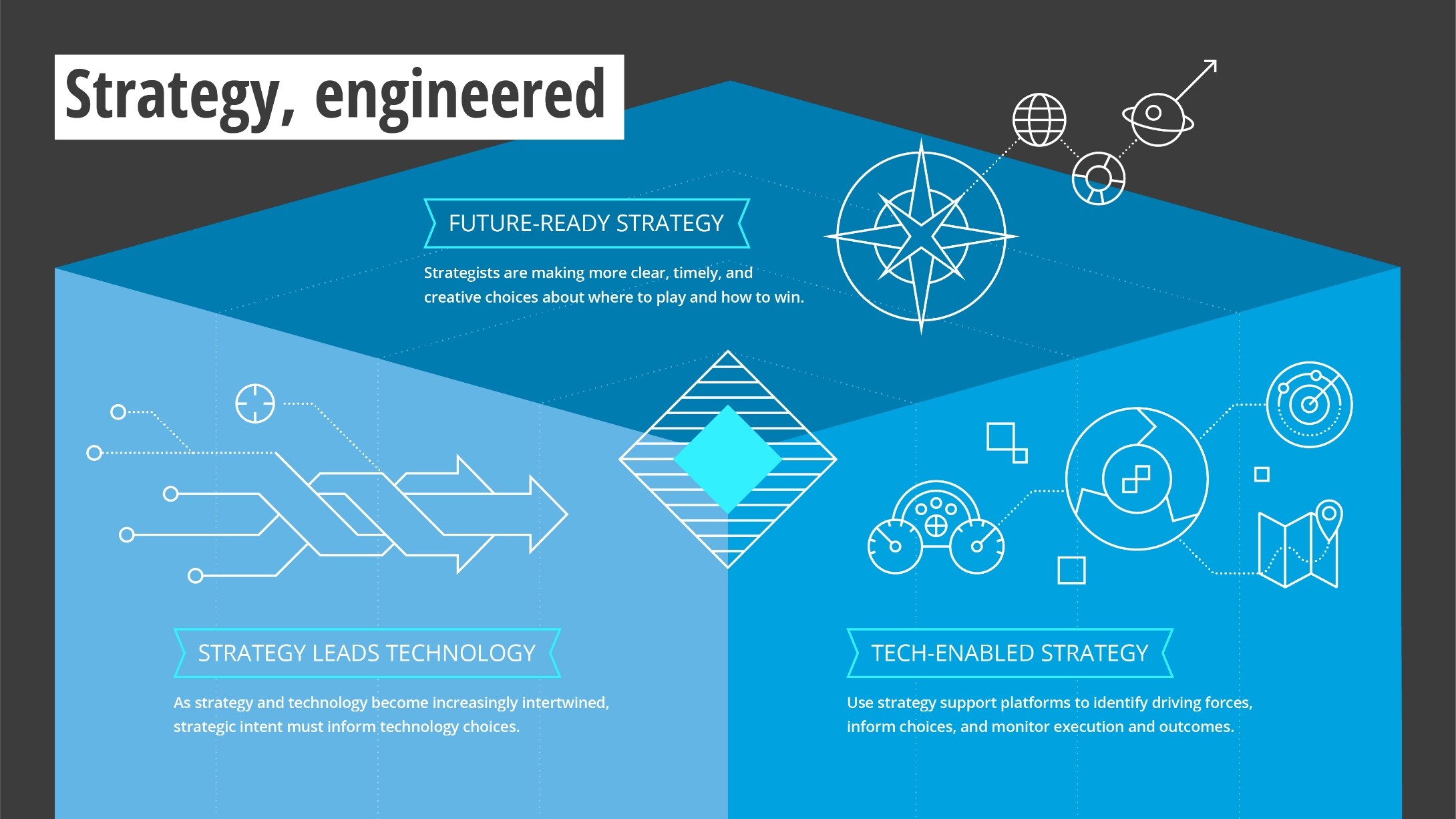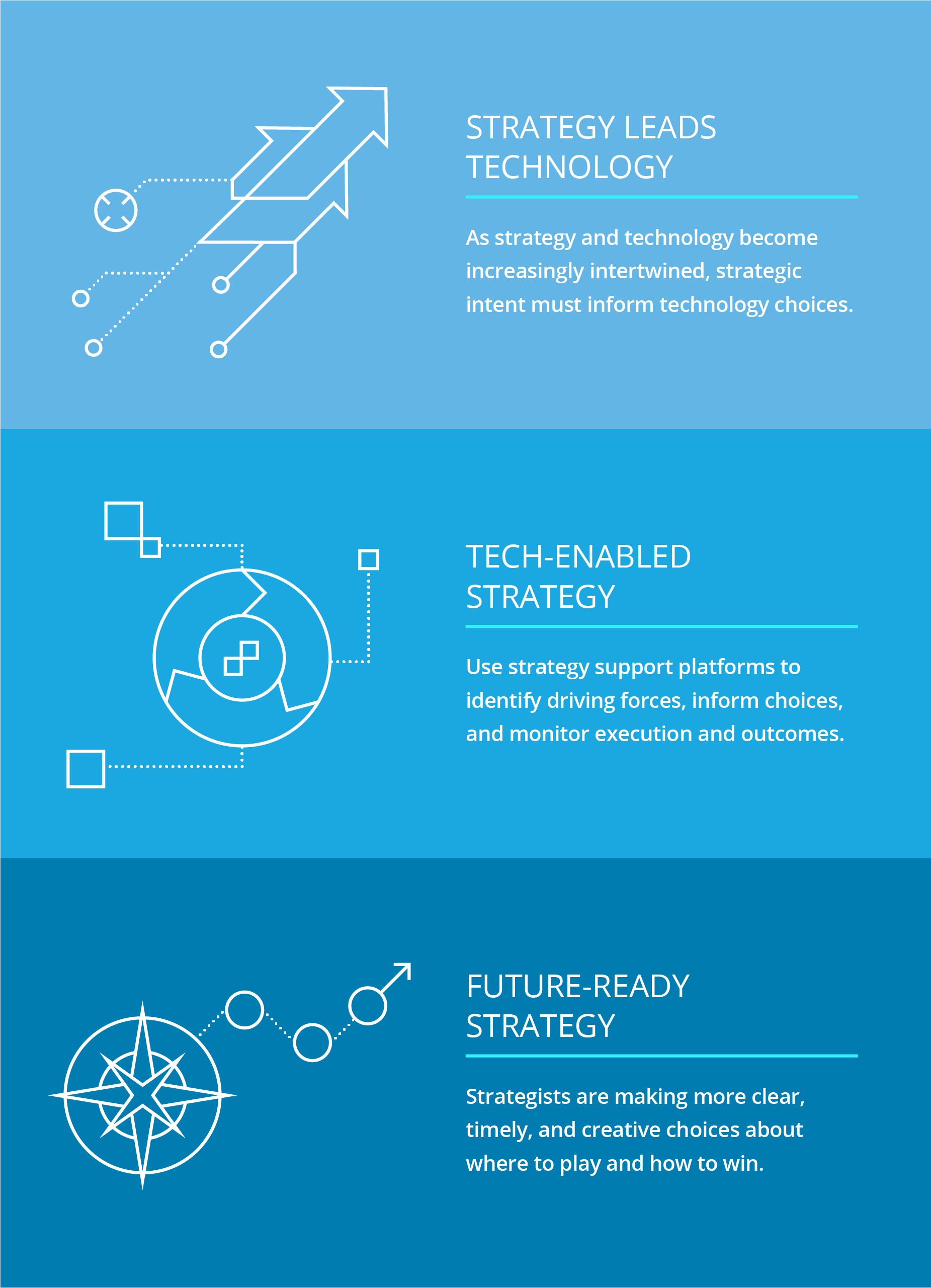Loading...
Strategy,
engineered
engineered
Tech-enabled business
strategy, optimized
for agility
strategy, optimized
for agility
Strategy,
engineered
engineered
Tech-enabled business
strategy, optimized
for agility
strategy, optimized
for agility
In a world where technology has emerged as a mighty strategic disruptor, savvy strategists are looking to make more clear, timely, and inspirational choices about future possibilities, continually scanning the horizon
for new competitive advantages they can deploy and threats they should avoid. A growing number of organizations are also proactively pursuing novel competitive advantages by joining forces with existing and
new ecosystem partners—from government and nonprofit agencies to complementary corporations and even “frenemies”—to envision how their combined offerings could expand where they play and how they win.
Winning in a volatile environment requires an integrated corporate and technology strategy, enabling organizational nimbleness, scalability, stability, and optionality.1 The traditional process of strategy development is too infrequent and labor-intensive to enable strategists to sense and seize opportunities as they emerge. A growing number are shifting to a fluid and agile
process for formulating, evaluating, and executing corporate and business unit strategies by employing technology tools that continually sense, anticipate, and monitor the effectiveness of their strategic choices
and execution.
The result: more timely and smarter choices that could lead to faster adaptation, bolder strategic choices, and sustainable competitive advantage.
Close the technology and business strategy chasm
As business strategy and technology strategy become increasingly intertwined, many corporate executives are finding that their organization’s past technology choices are limiting their strategic options and business
agility. To resolve these technology limitations, these executives are finding it necessary to lean in to technology architecture and technology implementation choices to ensure the overall business strategy is
supported by clearly aligned technology choices.
Obviously, having a strategy sitting on the shelf isn’t enough—effective execution is critical. And when asked about their strategic priorities and ability to execute, CSOs with disruptive, digital ambitions lack confidence in their ability to execute.
In Deloitte’s 2020 CSO Survey,
2 most respondents (70%) rated disruptive growth as critical for their companies’ success, but only 13% are confident
that their company can deliver on this strategic priority.
Effective execution requires continually monitoring the underlying strategic choices and assumptions, adjusting as needed. Even though most survey participants say they are seeking disruptive growth, 71% report spending more than three months on a single
round of strategy development. Nearly half (45%) refresh their strategy annually, or even less frequently: every two years (23%) or three years (22%).
Ultimately, strategists should collaborate with tech leaders to confirm that the organization’s critical technologies support the organizational strategy—and that the organization’s technologists have the right framework and understanding of the corporate
strategy to make their day-to-day technology decisions.
Getting from here to there
Agile strategy development and execution doesn’t happen in a vacuum—to generate effective results, organizations need foundational elements in place.
- Empowered strategy function. Whether it’s the CEO, CSO, or other executive, an empowered executive strategy leader is critical to effective strategy development and execution. In collaboration with the CIO, the strategy leader can help expand and shape the vision of executive leaders and board members. As one executive from a leading oil and gas company said, “The CSO needs to challenge long-held views and get our fellow executives to think about a market environment that is different from the existing one.” The successful strategy leader reinforces strategic discipline by looking beyond the organization’s daily challenges, aligning key technology choices, and continually scanning the horizon to anticipate emerging challenges.
- Tech-savvy C-suite. C-suite executives and board members should have a broad understanding of the critical technologies in which the company is, or should be, investing to gain competitive advantage and to build resilience against disruption. Leaders need to be supportive of investing in a portfolio of technology investments, from proofs of concept to test emerging technologies to major implementations of proven platforms. Moreover, executives need to help challenge the critical assumptions of those implementing the technology to help make sure the implementation will be driving value for the enterprise.
- Business-savvy tech leaders. Likewise, IT leaders and technologists should be engaged in strategy development processes and education that gives them a broad understanding of the business and its strategic objectives. As strategic partners, tech leaders can help strategy and business leaders identify and explore emerging technologies that support the strategic vision, with the objective of aligning the organization’s technology and corporate strategies. In fact, in a Deloitte–Wall Street Journal Intelligence survey, 40% of CEOs said their CIO or tech leader will be the key driver of business strategy—more than the CFO, COO, and CMO combined.3 Further, big technology bets require the active participation of the CEO/CSO to ensure that the organization’s tolerance for risk is honored and well managed.
- Aligned technology and partners. Effective organizations choose their technology platforms and ecosystem partners carefully, aligning their choices and implementation decisions with their strategic goals. When selecting important ecosystem partners, evaluate their long-term motives and agendas to understand whether their objectives and aspirations align with yours. In a worst-case scenario, a platform partner could become a competitive threat after they “learn” your industry.
- Collaborative list of strategic assumptions. Early in the strategy development process, lead strategists, tech leaders, and ecosystem partners should explore and challenge the assumptions for a tech-enabled strategy to be effective. Consider holding the discussion in a neutral environment such as a workshop, where egoless answers are encouraged and cataloged so they can be used later to flag leading indicators of the strategy’s success or failure.
- Agile funding. Executing on agile strategies demands a flexible process for planning and funding the technology investments required to implement strategies. For insights into how to finance innovation at the speed of agile, see Tech Trends 2020: Finance and the future of IT.
Next up: Tech-enabled strategy
To compete in an increasingly complex world, not only are the strategies becoming more digital—so is the process of developing and executing strategies and monitoring outcomes. As leaders are forced to consider a wider range of variables and future scenarios,
tech-enabled strategy platforms can help strategists think more expansively and precisely about the wide range of future possibilities.
Technology can also help leaders gain insight into seemingly unrelated occurrences that can drive smarter strategic choices on a continual basis. Strategists should evaluate technologies that help empower their imagination by identifying driving forces,
informing strategic decisions, and monitoring outcomes. (See sidebar, “Strategy support technologies.”)
Finally, technology plays an increasingly important role in helping companies translate a strategy into strategic initiatives, facilitate strategy execution, and monitor a strategy’s impact in the marketplace.
Strategy support technologies
Advanced strategic platforms equipped with advanced analytics, automation, and AI, including natural language processing and machine learning, can help leaders think more expansively and precisely about the wide range of future possibilities.
Identify strategic forces
Trend-sensing technologies continually scan the environment, collecting, analyzing, and clustering leading indicators that challenge or confirm strategic assumptions to facilitate quick responses.
- External: Changes in society, technology, politics, economy, environment, and regulations
- Business: Shifts in industry dynamics, customer expectations, competitor moves, and stakeholder behaviors, attitudes, and emotions
- Organizational: Trends in products/services, operations, asset base, costs, and branding
Example: The US Department of Homeland Security uses automated tools that scan news articles, patent filings, and more to identify emerging technologies that might disrupt or improve the process of securing the
United States.
Inform strategic choices
Dynamic scenario tools and simulators help leaders identify threats and opportunities, quickly test potential outcomes of strategic choices, and prioritize critical uncertainties.
- Create alternate long-term scenarios to identify threats and opportunities
- Develop simulations to test various strategic choices
- Enhance human understanding and insight to determine potential implications, critical unknowns, and strategic responses
Example: Three health care organizations (provider, plan, plan/provider) developed an agent-based model to simulate how competitive value-driven care dynamics could evolve, giving each organization new insights
into where to play and how to win.
Monitor execution and outcomes
Analytics technologies continually track internal and external outcomes to inform ongoing leadership discussions and decisions regarding the organization’s performance against the strategy:
- Are we honoring our strategic choices?
- What’s working? What’s not working? What adjustments are needed?
- Is our strategy and its associated commitments generating the projected value?
Example: Deloitte uses AI-based sensing to monitor the trajectory of two important uncertainties that affect the firm’s strategy: degree of regulation and technological/automation impact on professional services.
The way forward
Strategy development is not a one-and-done exercise but, rather, an ongoing, cyclical process. As technology and business become increasingly intertwined, business strategy drives technology strategy and vice versa. Around and around it goes—to the point
where the complexity of known and unknown strategic drivers inside and outside the organization could blow the mind of even the most nimble-brained strategist.
While accelerating technology is a strategic complicator, executives can deploy it to simplify and accelerate smart strategy development and execution. Leading organizations are engineering their strategic function to be more agile, scalable, and stable,
giving them an array of strategic options in their back pocket for whatever the future holds.

“Having a strategy sitting on the shelf isn’t enough—effective execution is critical.”
My take

Joseph Fuller, professor of management practice, Harvard Business School
“Everyone has access to similar technologies—but it’s how you use them that makes the competitive difference.”
One thing I know about strategy: It’s the assumptions that kill you, not your competitors. Over the past 30 years, I’ve urged corporate strategists to identify and rigorously test key assumptions about their strategy,
as well as their assumptions about the technology that will support it. Strategists should know exactly what assumptions they are making about their strategy and the supporting technology—and the competitive results
they expect.
Corporate strategy has never been easy, but technological advances have made strategy development even more complex. Technology choices used to be binary: Either a software or hardware choice goes live or it doesn’t. Today, the choices are more nuanced
and intertwined. For example, in the 1960s, airline strategists were deciding, “Do I buy a jet or stick with propeller aircraft?” But in recent years, the technology choices have become much more numerous and intricate:
What tech will I use to manage pricing? Flight crew? Maintenance scheduling? Route assignments? Once implemented, these technology decisions are baked into everyday operations and are difficult to change.
Until recently, it’s likely that the airlines assumed that business travel would remain relatively stable. As we’ve seen this year, when a key assumption turns out to be wrong, the strategy can quickly unravel.
Of course, the outcome of any important strategic choice is inherently unknowable. You’re never going to reduce the gray area to zero, but you can install controls that warn you that an important assumption is under question or, in fact, invalid. One
way to do this is to ask the right questions. No one expects CEOs and CSOs to keep up with all the latest technologies, but they should know enough to ask the hard questions: How will this technology interact with
our strategic assumptions? What problem will it solve, or what uncertainty will be reduced? What advantage will we gain from it?
And just as important: What assumptions about the technology itself must be true for these results to materialize? Too often, leaders and technologists succumb to magical thinking—if we invest in this technology,
it will solve all these other problems. Instead, effective strategic leaders don’t accept the promised benefits at face value—they carefully probe the logic behind the proposals, searching for disconfirming data,
to make sure the technology team has carefully thought through their assumptions about how the technology will advance the strategy without taking on inadvertent risk.
As assumptions multiply and tangle, the human brain needs help to anticipate outcomes and make course corrections. New technology tools can help strategists experiment with strategic theories, test the assumptions’ validity and likely outcomes. Rapid
simulation and experimentation can provide a quick, early read on possible outcomes while avoiding implementation risk. During execution, technologies can continually monitor the assumptions’ validity in real time,
providing insights that strategists can use to quickly and confidently course correct if needed. Additionally, sensing technologies can function as an early warning system to alert strategists when assumptions are
being challenged.
Many of these strategy support technologies incorporate cognitive AI, which helps take the human ego out of the equation when decisions don’t work out as anticipated. It’s human nature to overlook or discount data that doesn’t support our beliefs, but
a machine has no ego, which allows it to be objective. Plus, a machine can quickly pinpoint one exception out of thousands and identify subtle—but crucial—patterns and connections that could overturn a strategy.
These capabilities significantly improve the odds that a human strategist will recognize a strategic flaw and fix it before it’s too late.
In the end, though, the strategist’s capabilities are more important than the technology she uses. I often tell my MBA students about a NASCAR experiment that gave each driver the same vehicle and pit crew. The researchers found that even when drivers
have the same “tools,” some perform better than others, simply because of their innate abilities and experiences. So, my advice to strategists is that everyone has access to similar technologies—but it’s how you
use them that makes the competitive difference.
My take

Peter Schwartz, senior vice president of strategic planning, Salesforce
“It’s up to leaders to figure out a new future—otherwise, it will be determined for them.”
I’ve been working with scenario planning since the early 1980s and have even written several books on the topic, so the skills I’ve developed over the years are particularly useful now. This pandemic is the biggest crisis the world has seen in nearly
a century, and it’s important that leaders recognize that the old normal is gone forever. It’s up to leaders to figure out a new future—otherwise, it will be determined for them.
The pandemic has accelerated the pace of technological change, so when I think about technology and strategy, it is in the context of a malleable world of possibilities that didn’t exist before. Because there are so many unknowns during the pandemic,
we temporarily shortened our planning horizon at Salesforce to nine-month scenarios to inform our strategic choices about the technology that will be needed in this new world and how we could tackle even bigger
problems.
We are also working to harness the strategic thinking of our 50,000-plus employees. We’ve pivoted from the centralized communications cascade we used before the pandemic to a hyperdistributed enablement of strategic thinking. We gave every employee a
copy of our near-term scenarios and asked them to consider: How do you need to operate and adapt to this environment? How are you going to help your customers do this, too?
Of course, we don’t send them off without context. Every Wednesday, we have an all-hands call to keep our people up to date. We gave them a playbook that provides guidance for how to think about running their part of the company and how to interact with
customers during this transition. But we didn’t provide specific actions they should take—instead, we suggested the questions they should be asking themselves in this new environment.
Moreover, to succeed in an accelerating world where strategies and tactics are merging, leaders need to know what’s going on. The ability to capture and display information for decision-making becomes hyperrelevant when you need to move this fast. Quickly
adjusting strategy and tactics requires real-time data and sophisticated tools to create scenarios and forecasts.
For example, we’re helping health agencies in California and Hawaii, as well as our own global organization, anticipate where the COVID-19 virus could spread next. We’re using a mobile survey tool that follows cell phone movement without capturing personally
identifiable information. When many cell phones move from a coronavirus hot spot to another area, the tool alerts local health organizations to give them time to prepare.
Another example was the design and launch of Work.com in early May 2020. This new product helps businesses and communities get back to work safely. We accomplished in one month what would normally take a year.
When you move this quickly, the organization’s operational cadence must accelerate as well. During every good scenario exercise, leaders identify the leading indicators of potential problems. Our senior executives, especially Marc Benioff, are very familiar
with these indicators and frequently question operational leaders to head off problems before they can materialize. If something is supposed to happen and doesn’t, it’s noticed very quickly.
In times of crisis, business leaders have a different role than in ordinary times. In terms of strategy and tactics, it’s insufficient to consider only how we can help our businesses. We need to step up and help deal with the crisis itself. How can we
help our community and society? How can we help the world deal with this crisis? By engaging all of our people in bottom-up, independent thinking and innovation, we can do our part to help design the
world’s new future.
Learn more
Download the trend to explore more insights, including the “Executive perspectives” where we illuminate the strategy, finance, and risk implications of each trend, and find thought-provoking “Are you ready?” questions to navigate the future boldly. And check out these links for related content on this trend:
- 2020 Chief Strategy Officer Survey: Learn how corporate strategy leaders are evolving to navigate uncertainty and change strategic planning.
- Uncovering the connection between digital maturity and financial performance: Gain insights into the key “digital pivots” that can affect financial performance.
- A case of acute disruption: See how lessons of digital transformation can prepare an organization’s response to sudden and severe disruptions.
Next Trend:
Senior contributors
Nicholas Reed, Bruno Kakoobhai, and Raul Silva
Endnotes
Endnotes
1.
Gerald C. Kane et al., The Transformation Myth: Leading Your Organization through Uncertain Times (MIT Press, forthcoming 2021).
2.
Bernardo Silva et al., 2020 Chief Strategy Officer Survey: Evolving the corporate strategy function for a world of disruptive change,
Deloitte Insights, April 16, 2020.
3.
Khalid Kark et al., “Survey: CIOs are CEOs’ top strategic partner,”
Deloitte CIO Journal on the Wall Street Journal, May 22, 2020.









